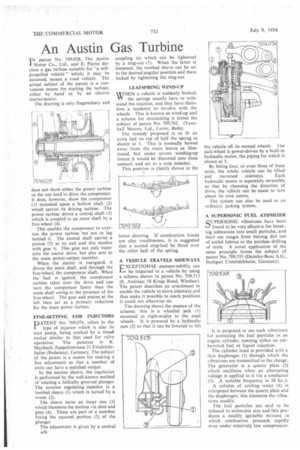An Austin Gas Turbine
Page 62

If you've noticed an error in this article please click here to report it so we can fix it.
IN patent No. 709,028, The Austin I Motor Co., Ltd., and E. Payne disclose a gas turbine suitable for "a selfpropelled vehicle" which, it may be assumed, means a road vehicle. The actual subject of the patent is a convenient means for starting the turbine, either by hand or by an electric starter-motor.
The drawing is only fragmentary and does pot ihow.either the power turbine or the one used to drive the compressor. It does, however, show the compressor (1) mounted upon a hollow shaft (2) which carries its driving turbine. The power turbine drives a central shaft (3) which is coupled to an outer shaft by a free-wheel (4).
This enables the compressor to overrun the power turbine but not to lag behind it. The central shaft carries a pinion (5) at its end and this meshes with gear 6. This gear not only transmits the starter drive, but also acts as the main power-output member.
When the starter is energized, it drives the main shaft, and through the free-wheel, the compressor shaft. When the fuel is ignited, the compressor turbine takes over the drive and can turn the compressor faster than the main shaft owing to the presence of the free-wheel. The gear and pinion at the left then act as a primary reduction • for the main power turbine.
FINE-SETTING, FOR INJECTORS
PATENT No. 709,074, refers to the type of injector which is also its own pump, being worked by a timed rocker similar to that used for valve operation. The patentee is K. Mavbach, Zeppelinstrasse 21 Friedrichshafen (Bodensee), Germany. The subject of the patent is a means for making a fine adjustment so that a number of units can have a matched output.
In the section shown, the regulation is performed by the well-known method of rotating a helically grooved plunger. The exterior regulating member is a toothed sleeve (1) which is turned by a worm (2).
The sleeve turns an inner one (3) which transmits the motion via slots and pins (4). These are part of a member fitting the squared portion (5) of the plunger. '
The adjustment is given by a conical A36 coupling (6) which can be tightened by a ring-nut (7). When the latter is loosened, the toothed sleeve can be set to the desired angular position and there locked by tightening the ring-nut.
LEAFSPRING WIND-UP WHEN a vehicle is suddenly braked, VV the springs usually have to withstand the reaction, and they have therefore a tendency to revolve with the wheels. This is known as wind-up and a scheme for minimizing it forms the subject of patent No. 709,762. (Vauxhall Motors, Ltd., Luton, Beds); The remedy proposed is to fit an extra leaf on top of half the spring as shown at I. This is normally bowed away from the main leaves as illustrated, but under severe winding-up forces it would be distorted into close contact, and act as a stop member.
This position is clearly shown in the lower drawing. If acceleration forces are also troublesome, it is suggested that a second stop-leaf be fitted over the other half of the spring.
A VEHICLE TRAVELS SIDEWAYS
XCEPTIONAL rnanceuvrability can I—I be imparted to a vehicle by using a scheme shown in patent No. 709,513 (E. Andreae, 58 Kings Road, Windsor). The patent describes an attachment to enable the vehicle to move sideways and thus make it possible to reach positions it could not otherwise do.
The drawing shows the essence of the scheme; this is a wheeled jack (1) mounted at right-angles to the road wheels. It is powered by a hydraulic ram (2) so that it can be lowered to lift the vehicle off its normal wheels. the jack-wheel is power-driven by a built-in hydraulic motor, the piping for which is shown at 3.
By fitting four, or even three of these units, the whole vehicle can be lifted and traversed sideways. Each hydraulic motor is separately reversible so that by choosing the direction of drive, the vehicle can be made to turn about its own centre.
The system can also be used as an ordinary jacking system.
A SUPERSONIC FUEL ATOMIZER QUPERSONIC vibrations have been L) found to be very effective for breaking substances into small particles, and their use ranges from forcing dirt out of soiled fabrics to the painless drilling of teeth. A novel application of the same principle forms the subject of patent No. 709,535 (Daimler-Benz AG., Stuttgart Untertarkheim, Germany).
It is proposed to use such vibrations for atomizing the fuel particles in an engine cylinder, running either on carburetted fuel or liquid injection.
The cylinder, head is provided with a thin diaphragm (1) through which the vibrations are transmitted to the charge. . The generator is a quartz plate (2) which oscillates when an alternating voltage is applied to it via a conductor (3). A suitable frequency is• 20 kc./s. ' A column of cooling water (4) is interposed between the quartz Plate and the diaphragm; this transmits the vibrations readily.
The fuel particles are said to be reduced to molecular size and this produces a readily ignitable mixture in which combustion proceeds rapidly even under relatively low compression.




























































































